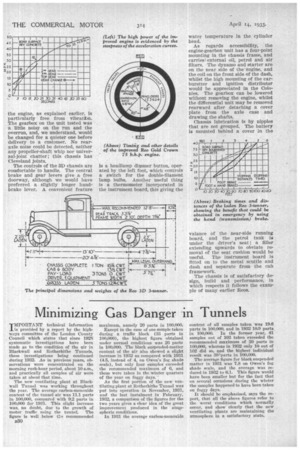Minimizing Gas Danger in Tunnels
Page 44

If you've noticed an error in this article please click here to report it so we can fix it.
IMPORTANT technical information is provided by a report by the highways committee of the London County Council which states that since 1928 systematic investigations have been made as to the condition of the air in Blackwell and Rotherhithe Tunnels, these investigations being continued during 1932. As in previous years, observations were concentrated on the morning rush-hour period, about 10 a.m., and practically all samples of air were taken at about that time.
The new ventilating plant at Blackwall Tunnel was working throughout the year. The average carbon-monoxide content of the tunnel air was 11.1 parts in 100,000, compared with 9.2 parts in 100,000 for 1931. This slight increase was, no doubt, due to the growth of motor traffic using the tunnel. The figure is well below the recommended 1130 maximum, namely 20 parts in 100,000.
Except in the case of one sample taken during a traffic block (53 parts in 100,000), the highest figure obtained under normal conditions was 26 parts in 100,000. The black suspended-matter content of the air also showed a slight increase in 1932 as compared with 1931 (4.5, instead of 4, on Owen's fog shade scale), but only four samples exceeded the recommended maximum of 6, and these were taken in the winter quarters of the year on foggy days.
As the first portion of the new ventilating plant at Rotherhithe Tunnel was put into operation in November, 1931, and the last instalment in February, 1932, a comparison of the figures for the two years gives a clear idea of the great improvement produced in the attn,ospheric conditions.
In 1931 the average carbon-monoxide
content of all samples taken was 19.6 parts in 100,000, and in 1932 10.9 parts in 100,000. In the former year' 41 samples out of 103 taken exceeded the recommended maximum of 20 parts in 100,000, whereas in 1932 only 10 out of 102 did so' and the highest individual result was 30-1parts in 100,000.
The average figure for black suspended matter in 1931 was 7.8 on Owen's fog shade scale, and the average was reduced in 1932 to 6.1. This figure would have been smaller but for the fact that on several occasions during the winter the samples happened to have been taken on foggy days.
It should be emphasized, says the report, that all the above figures refer to the worst conditions which -normally occur, and show clearly that the new ventilating plants are maintaining the atmosphere in a satisfactory state.




























































































